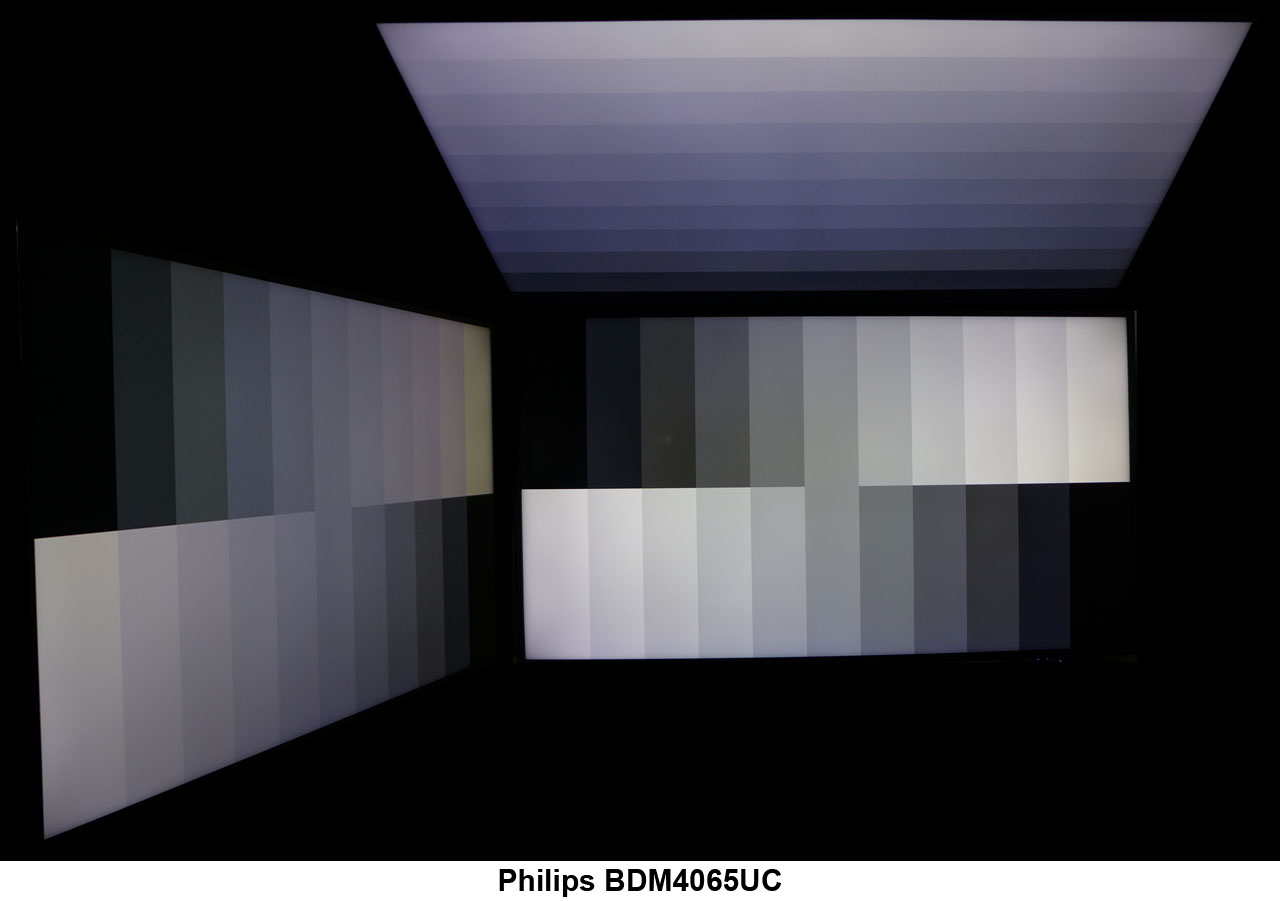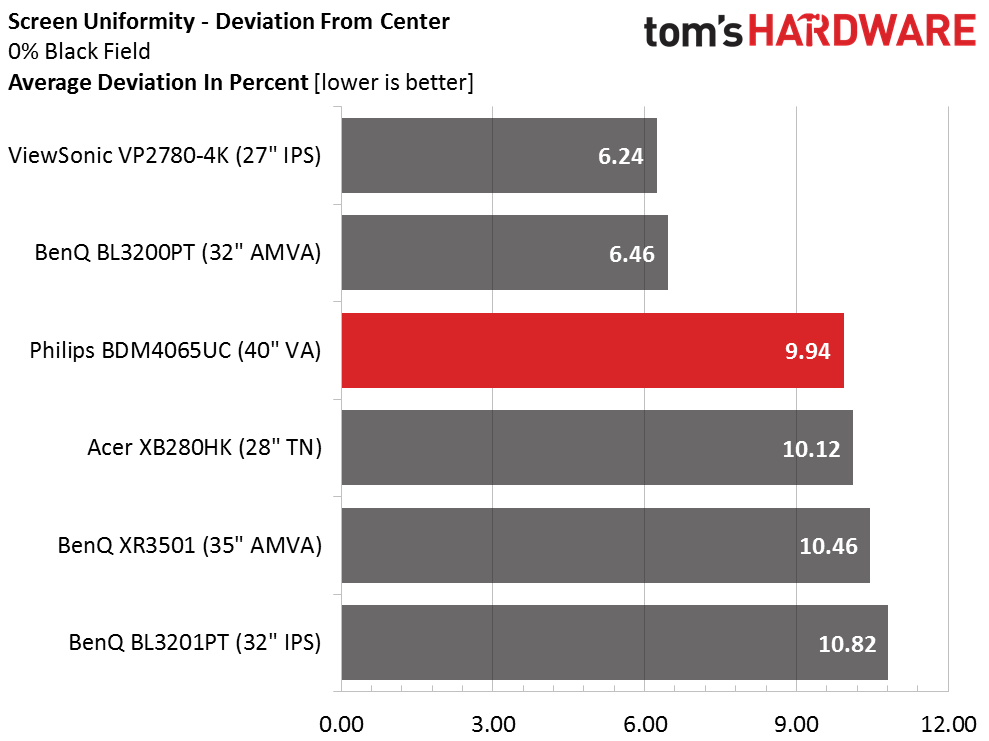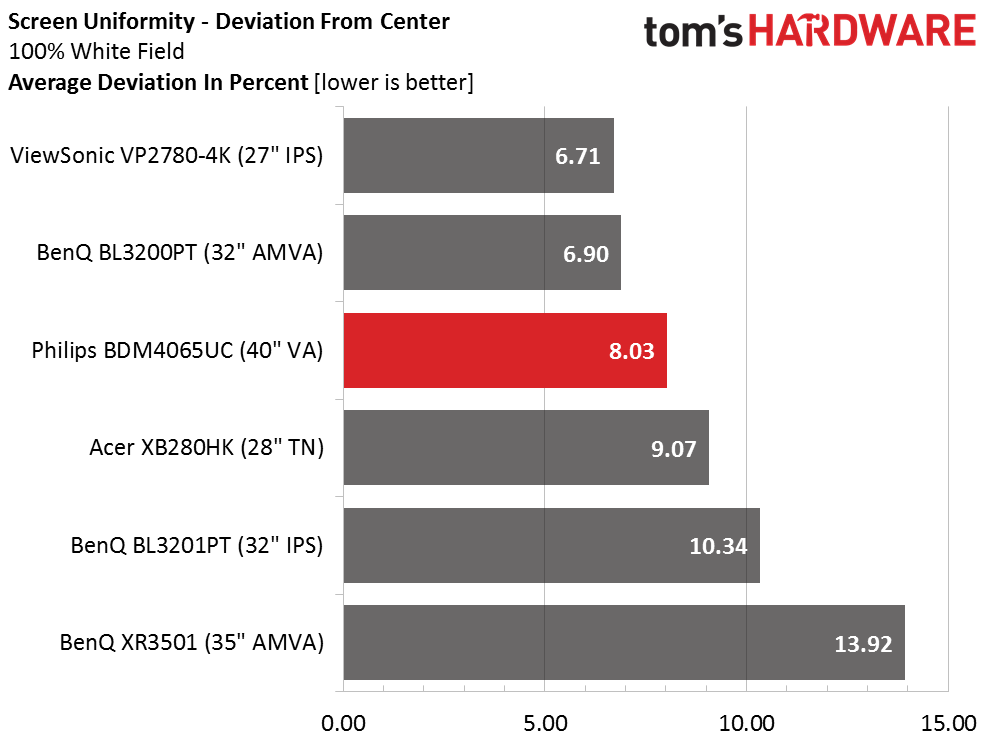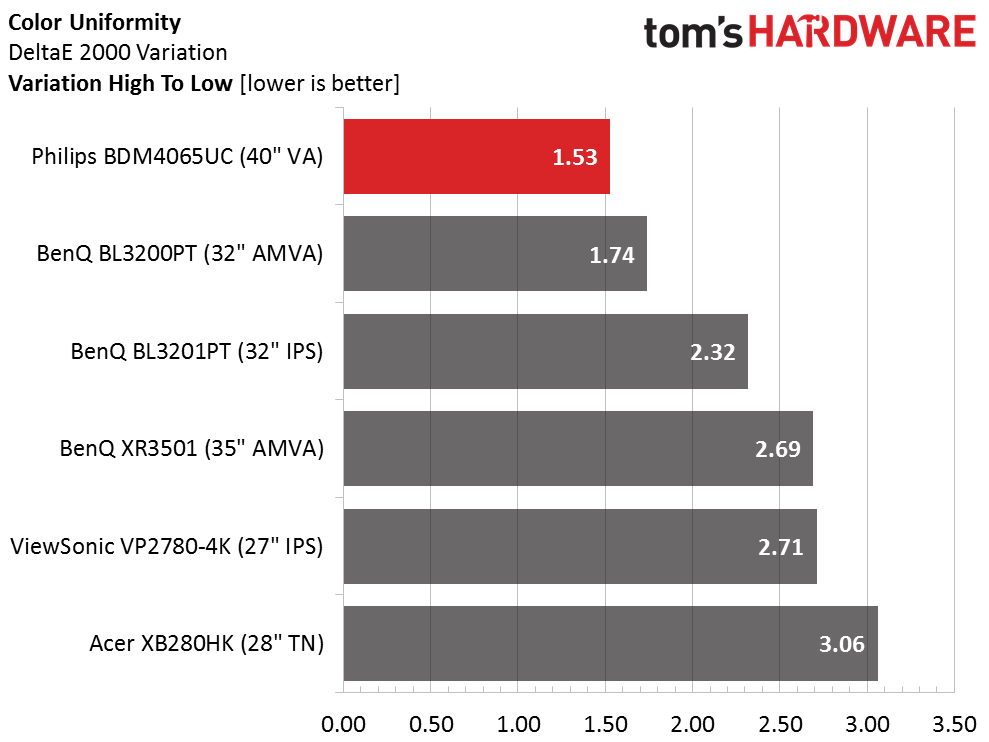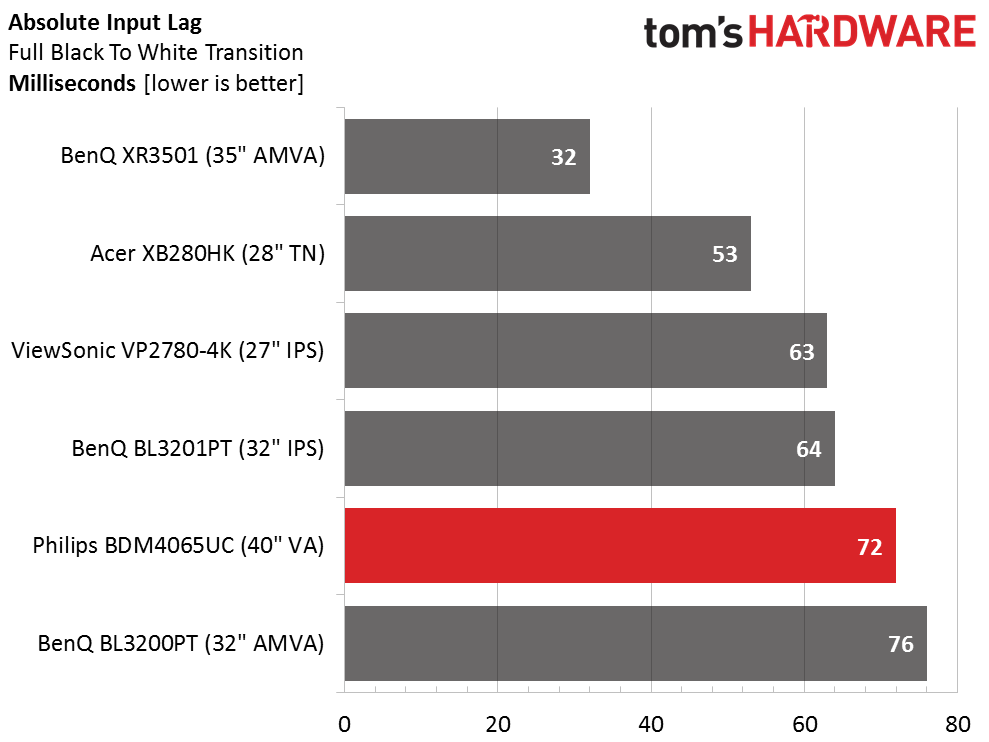Philips BDM4065UC 40-inch Ultra HD Monitor Review
Why would you put the Philips BDM4065UC on your desk? Because it's 40 inches with Ultra HD resolution and a 5000:1 contrast ratio. Today we check it out in our lab.
Why you can trust Tom's Hardware
Viewing Angles, Uniformity, Response And Lag
To learn how we measure screen uniformity, please click here.
VA panels sacrifice some off-axis image quality for their high contrast. VA is a variation of IPS and it handily beats TN in this test but the best viewing angles are found in AHVA panels. You can see an obvious light falloff and red shift in the horizontal plane. Looking from the top down there is a change in gamma and a slight purple tint.
Screen Uniformity: Luminance
It can be difficult to achieve good screen uniformity in large monitors but our sample had no problems to speak of. There is a uniformity compensation feature available in the SmartImage menu but as you saw on page three, it creates an unacceptable artifact and reduces contrast. With a test result like this however, there is no need to use it.
Here’s the white field measurement.
The white field test has a slightly better result. Regardless of the field pattern displayed, our sample looks perfectly uniform from edge to edge. There is no visible light bleed nor are there any hotspots.
Screen Uniformity: Color
Color uniformity is even better with a very-low 1.53dE variation. Even though this result can vary with different samples, it’s very likely your BDM4065UC won’t have any visible color shifts.
Pixel Response And Input Lag
Please click here to read up on our pixel response and input lag testing procedures.
Get Tom's Hardware's best news and in-depth reviews, straight to your inbox.
Philips lists a three millisecond result for its gray-to-gray test. Our test is full black to white and takes longer to draw the frame. 25ms is pretty typical for a monitor running at 60Hz. We experimented with the overdrive settings and found that anything above Fast resulted in too much ghosting due to excessive overshoot. In actual content, motion blur was no greater than any other 60Hz screen we’ve gamed on.
Here are the lag results.
None of the Ultra HD monitors we’ve reviewed so far have super-low input lag. The Acer is the leader for now and will likely remain so until connection standards allow for refresh rates above 60Hz. The reason to game on a screen like this is resolution, not speed. Casual players like us have no problems in first-person shooters but elite gamers will want to go for a 144Hz display like the XR3501. The best balance between speed and pixel density right now is found in the 144Hz QHD genre with monitors like the Acer XB270HU.
Current page: Viewing Angles, Uniformity, Response And Lag
Prev Page Color Gamut And Performance Next Page Conclusion
Christian Eberle is a Contributing Editor for Tom's Hardware US. He's a veteran reviewer of A/V equipment, specializing in monitors. Christian began his obsession with tech when he built his first PC in 1991, a 286 running DOS 3.0 at a blazing 12MHz. In 2006, he undertook training from the Imaging Science Foundation in video calibration and testing and thus started a passion for precise imaging that persists to this day. He is also a professional musician with a degree from the New England Conservatory as a classical bassoonist which he used to good effect as a performer with the West Point Army Band from 1987 to 2013. He enjoys watching movies and listening to high-end audio in his custom-built home theater and can be seen riding trails near his home on a race-ready ICE VTX recumbent trike. Christian enjoys the endless summer in Florida where he lives with his wife and Chihuahua and plays with orchestras around the state.
-
Oleander Bought one back in january. Best decision ever!Reply
A lot of bad stuff were said about it in forums (for all the wrong reasons) so it's nice to see that for what I use it (non first-person gaming and all-round) this review vindicates it.
Only remaining issue is the flicker of the backlight if brightness is not at 100%, but since the brightness is so low, it's not a problem to me. -
cats_Paw For professional use, absolutely.Reply
For gaming, probably not (Black levels are amazing for LED panel, and also contrast is amazing, but color delta and input lag... no way).
Plasmas are still king for gaming in my books, too abd they are almost all gone by now. -
Maryland_USA A completely unique product? I don't think so. Several other 40-inch monitors are available that will drive a VA panel at 3840x2160@60Hz through both DisplayPort 1.4 and HDMI 2.0. They're sold by AMH, Crossover, Iiyama, MIcroboard, and Seiki. Step up to 43 inches, and you must add Wasabi Mango. All but the Seiki and Iiyama cost less than the Philips.Reply -
Larry Litmanen I currently game on a 32 inch TV, honestly you can not go back to a monitor with a better resolution that is 24 or 27 inches. Once you go big it is just amazing.Reply
It's not just the width, you also need that vertical screen real estate.
-
hotdogee "Nearly every LCD panel on the planet is made by either Samsung, LG or AU Optronics. A few are also made by Innolux (formerly Chi Mei). But the Philips BDM4065UC is made by TP Vision, which is the actual owner of the Philips brand."Reply
The panel is made by Innolux for TP Vision. -
Eggz Great to see this. Is tom's planning on reviewing the new LG 4K OLED displays? They would seem to score very well in just about every category that matters for professional use. I'd love to see it, and the reviewers would also probably enjoy playing with one. Consider it, please.Reply -
Xorak I used a 32" 1080p TV for a long time, so I completely get the appeal of a big screen with great contrast and vibrant color, even if it's not the fastest or most accurate. Now I'm used to my MG279Q and would not go back to a fixed refresh screen. I hoped that 4096x2160 would start catching on too, but it looks like it won't. In the next 2 years a single GPU should be able to make use of a true 4k panel with variable refresh up to 75 or 90hz and it would be a thing of beauty at 30+ inches.Reply -
enewmen Can someone explain why not to use Ultra HD LEDs TV for computer work? (another dumb post) For small font text (using 1080p TVs) , the TVs did'n't look as sharp as PC monitors. But I don't see that as a problem for 2160p TVs. Yes, the TV must have HDMI 2.0 and the graphics card must also support that. But is that the only reason? Anyway, the Philips looks like an UHD TV made for PC work at a price similar to TVs.Reply
I also personally don't like Display Port cables because only the BEST cables won't give problems with recovering from sleep mode. Gave up on Display Port and currently using DVI Dual Link at 1440p. -
mavikt ReplyGreat to see this. Is tom's planning on reviewing the new LG 4K OLED displays? They would seem to score very well in just about every category that matters for professional use. I'd love to see it, and the reviewers would also probably enjoy playing with one. Consider it, please.
I too would like to see a proper technical review of said (TV) tech.
In a home theater magazine I subscribe to they said that the latency was around 50ms (55EG960V), didn't say how it was measured though. Otherwise they said it was The Perfect TV.
So it remains to be seen if LCD will "remain the dominant tech for the foreseeable future"
